How to make Manhattan-style Fermented Pickles with Garlic and Dill! An easy step-by-step guide to making the most flavorful, crunchy, tangy pickles full of healthy probiotics with only 20 minutes of hands-on time! The pickle brine is like a “tonic” -drink a shot daily to support a healthy gut! Video.
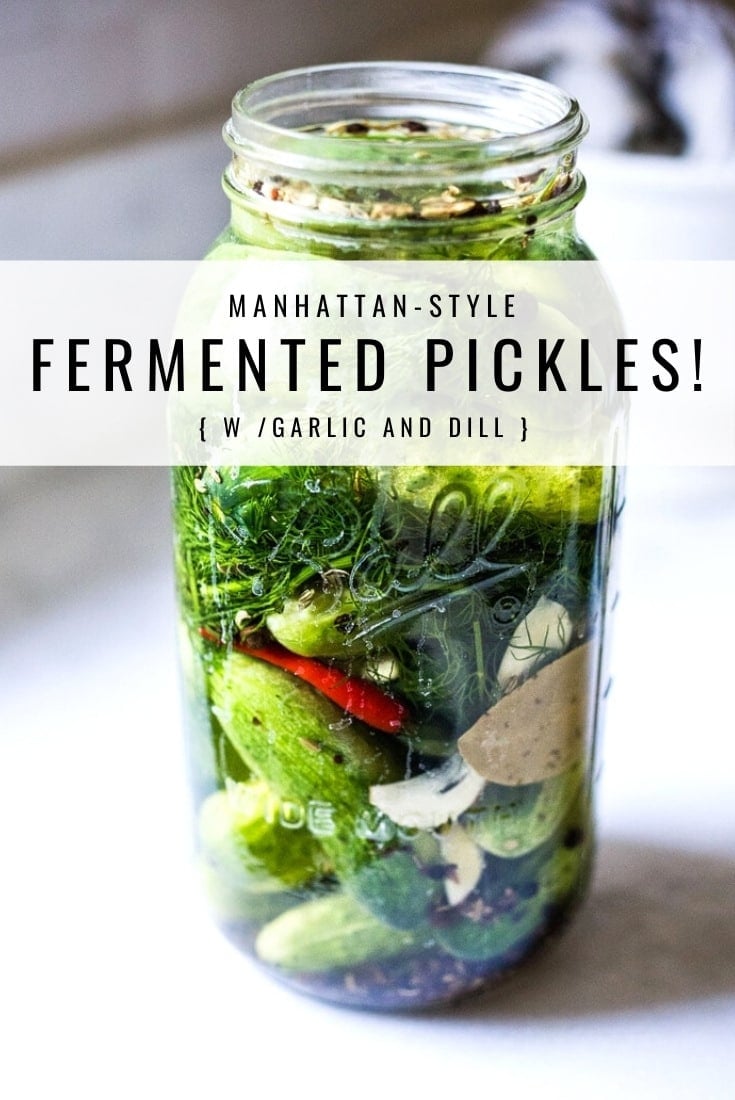
What happens when people open their hearts? They get better. ~Haruki Murakami
I’m excited to share this easy recipe for Fermented Pickles with you! If you are a crunchy pickle lover like me, you will be in heaven. Seriously, these are the best! These Manhattan-style “half-sour” fermented dill pickles are crispy, crunchy, flavorful, and oh-so alive!
Fermented in a salt brine, rather than vinegar, they get their delicious tanginess from light fermentation rather than vinegar.
Full of healthy, gut-healing, immunity-boosting probiotics these little guys are perfect as a low-calorie snack, or sliced and added to sandwiches or served as a tasty side.
Not only are they delicious and incredibly EASY to make, they are also incredibly good for us!
And as crazy as this may sound to some, the fizzy brine itself is like a healing tonic to me – I love to drink a shot of it- especially when I feel like my immunity needs a boost! So flavorful and totally energizing. Or try a Gin and Brine!
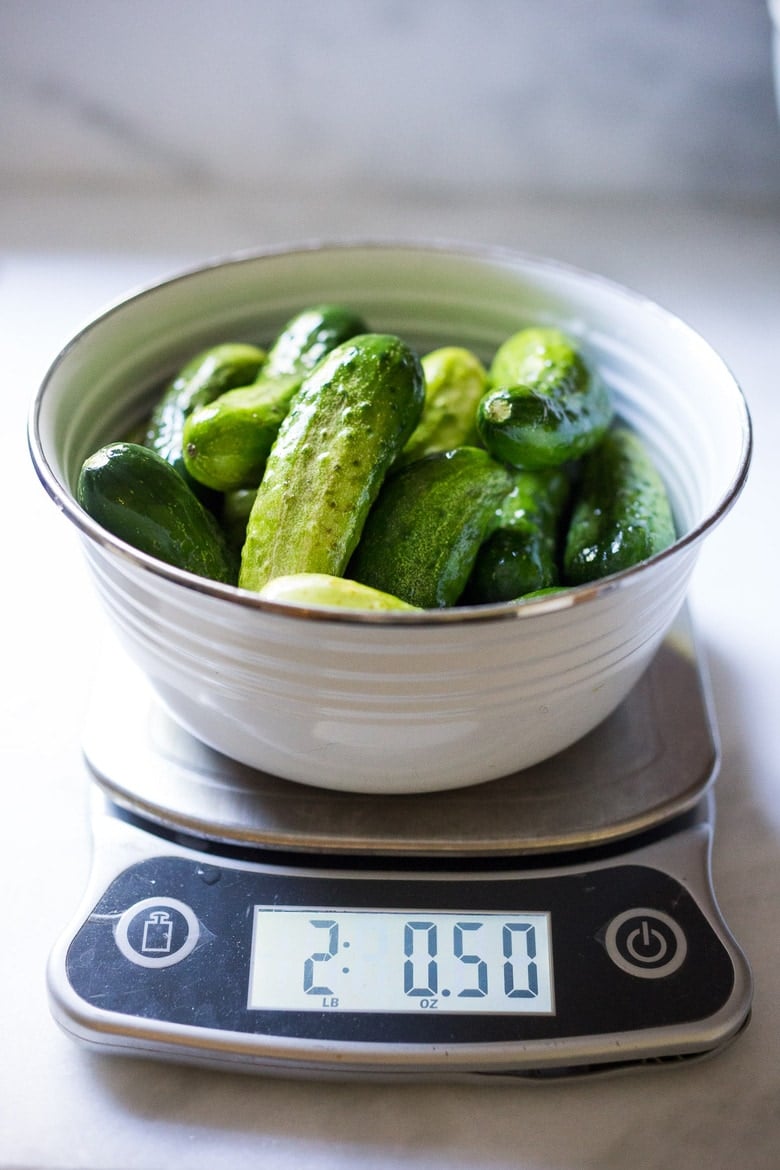
What you’ll need
- Pickling Cucumbers- Small and short (4 inches long) with thin bumpy skin, crisp texture, small seeds, a blocky shape and color gradient from light to dark. Varieties include Kirby, Calypso, Royal, Pickalot, National Picking, Adam Gherkin, Sassy, Eurika, Jackson, Boston Pickling, Northern Pickling… to name a few. You’ll need 2 lbs of “pickling cucumbers.” This recipe makes one large 1/2 gallon jar (or use two quart-sized jars) – a relatively small batch. Pickling cucumbers are most easily found at your local farmers’ market. Ask the farmers if they have “pickling cucumbers” they can help direct you to the right ones. Your pickles will only be as good as your cucumbers, so choose wisely! Make sure they are roughly the same size -about 4 inches long with 1 1/2-inch to 2-inch diameters – so they fit in the jar nicely and ferment at the same rate. I handpicked each one. They should be fresh and crisp with no soft spots.
- Salt-use fine sea salt, or fine Himalayan Pink salt
- Garlic and Onion – we load this up with 10-20 garlic cloves for the best flavor!
- Fresh Dill – use a big handful!
- Spices: Ground Turmeric ( adds fresh flavor) fennel seeds, mustard seeds, whole peppercorns, coriander seeds, whole allspice, dill seeds and celery seeds. Feel free to change or embellish! I added a couple of chilies for a little heat.
- Optional Tannic Acid: Bay leaves, grape leaves, oak leaves, or a couple of slices of fresh horseradish root. Cucumbers contain enzymes that soften them. To prevent this add a few bay leaves or a grape leaf to the jar.
- Two-Quart Mason Jar ( 8 cup mason jar)
- Fermentation weights
- Optional: Air lock, gasket, metal ring
How long does it take to ferment pickles?
These 3% Brined, half-sour crunchy pickles take 3-5 days of fermenting time.
The Brine: SALT TO WATER RATIO
- This recipe is a 3% salt water brine, which is considered “safe”. It equals 7 grams of salt per 1 cup of water. Or, 1 heaping teaspoon salt (1 1/4 teaspoon salt ) per 1 cup of water. This ratio allows one to drink the brine (like a shot) because it is not too salty and is designed for a shorter fermentation period ( 3-5 days). Crunchy, lightly fermented pickles!
- If you want a stronger brine for a longer ferment, feel free to go up to 4.5%. So for example, 3.5% Ratio= 9 grams of salt per 1 cup of water, 4.5% brine =10.8 grams of salt per 1 cup of water. For a 4.5% brine, half-sour pickles take 5-7 days, full sour pickles 14-21 days.
Fermented Pickles (step-by-step Instructions)
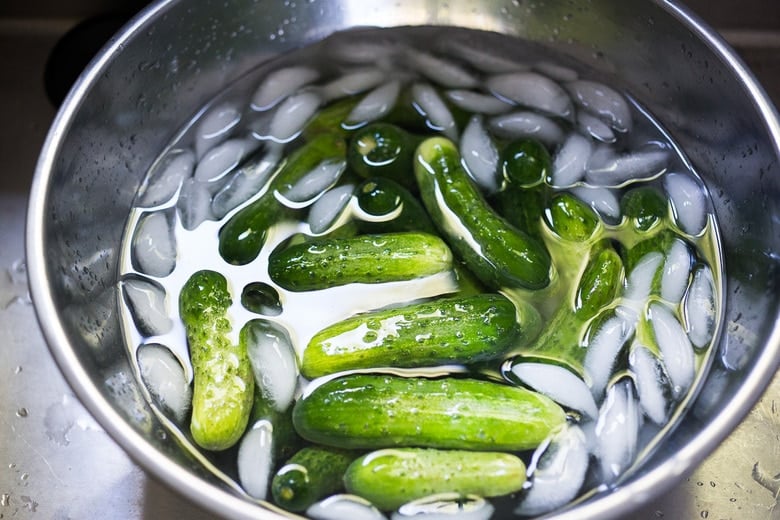
Step 1: Wash the cucumbers, slice off 1/16 inch of the blossom end, and soak them in an ice bath for 15-30 minutes to firm and crisp them up. There are enzymes in the blossom end that can make your pickles soft, so be sure to remove them.
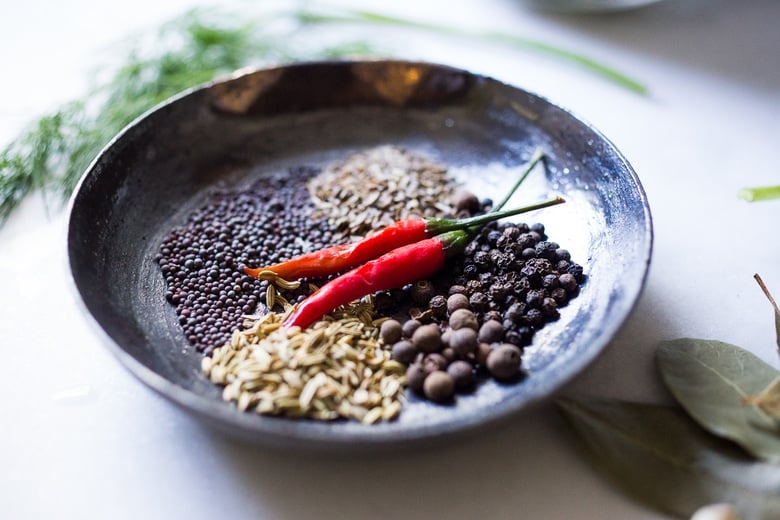
Step 2: Slice the garlic lengthwise and gather your spices.
Because these fermented pickles are left whole, you want the brine to be extra flavorful. I add a lot of garlic… 10-15 cloves, sometimes 20! Fermented Garlic is really good for the gut too!
Step 3: Place the spices on the bottom of the jar, then sliced garlic, fresh dill and bay leaves, and then add 2 layers of cucumbers, end on end, in a large two-quart jar (half-gallon). Press everything down.
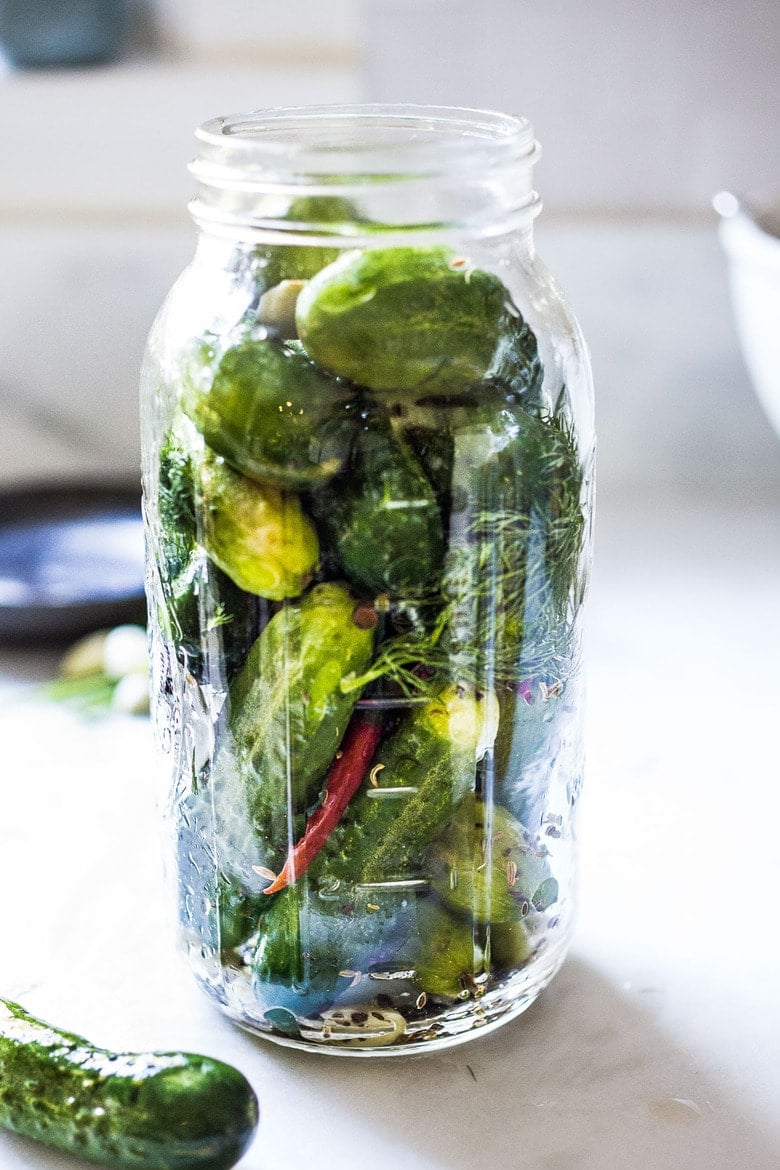
Step 4: Carefully measure and mix salt and water to create the 3% salt water brine- then pour this brine over the pickles leaving 1 1/2 inches of headroom.
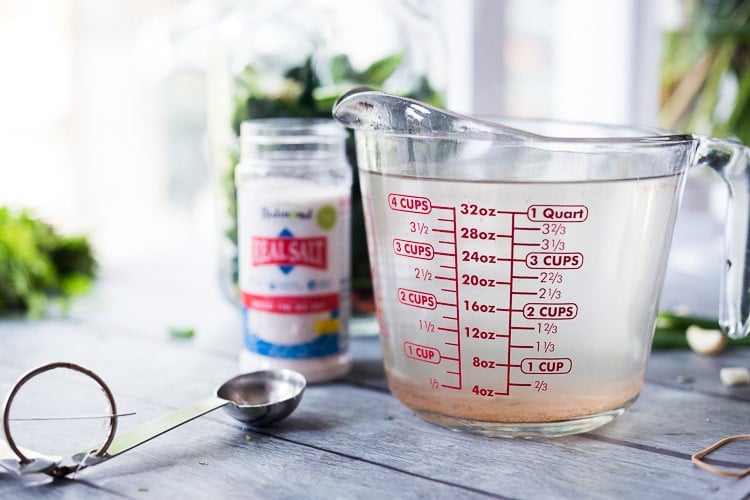
How salt works in fermentation:
- In a nutshell, using the right ratio of salt in fermentation encourages the growth of healthy bacteria while at the same time killing off bad bacteria. You want to be precise when measuring the salt and water in these kinds of recipes.
- Too much salt may kill off ALL of the bacteria -preventing fermentation.
- Too little salt will allow bad bacteria to keep on living. It is a fine balance. 😉
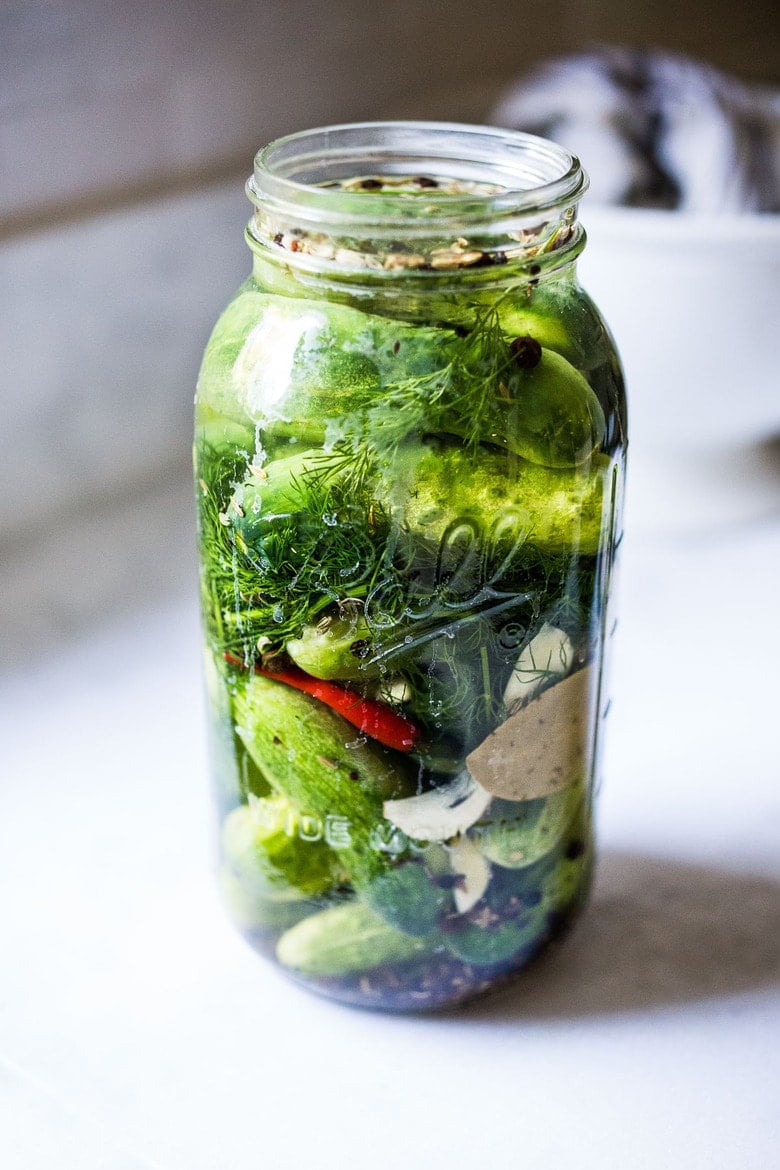
Step 5: Weigh down the cucumbers so they are completely submerged under the liquid, using a couple of fermentation weights, or a small zip lock bag filled with a little water (in a pinch).
MOLD: If the cucumbers or seeds are not submerged under the brine and become exposed to air- they can develop mold, so spoon any floaters out with a slotted spoon. Most seeds should stay submerged.
Step 6: Cover loosely with a lid or towel (to prevent bugs or flies from coming in, and to allow gases to escape) place in a bowl or pan to catch any overflow, and place in a cool dark place for 3-7 days, like the basement. You can also use and airlock lid- which allows air to escape, but nothing to fly in.
Step 7: Check after 2-3 days. Look for signs of life: bubbles/ or cloudy water. A cloudy brine is GOOD. Tap the jar and see if bubbles rise to the top. Check to see if any brine overflowed into the bowl ( both signs of life). This often takes about 3-5 days, I find 4 days is the “sweet spot”, depending on temperature. Cloudy brine is delicious and nutritious!
Step 8: Place the jar in the fridge to further slow the fermentation with a loose lid. They will continue to ferment very slowly and will keep indefinitely.
Expert Tips:
- Ferment at cooler temps (60-70F) to keep pickles crisp. If your home is hot, try placing in a cooler with ice. Take the temp of the brine.
- The longer you ferment them (unrefrigerated), the tangier they will get. But they will also get softer. I like them crisp, but you may want them tangier and softer. You can taste them at any point after you see bubbles.
- Smell: your ferment should smell tangy, garlic and fresh. If you notice anything foul or unpleasant, your ferment may have been contaminated: most commonly by dirty hands, dirty utensils, or a dirty jar.
- If you want to create a “fizzy” brine for drinking, tighten the lid, and burp daily if leaving out. You can tighten the lid in the fridge, but burp weekly. This will create a little pressure and give it some effervescence.
- Anything that touches air- may mold. Always fish out any floating spices with a slotted spoon to prevent this.
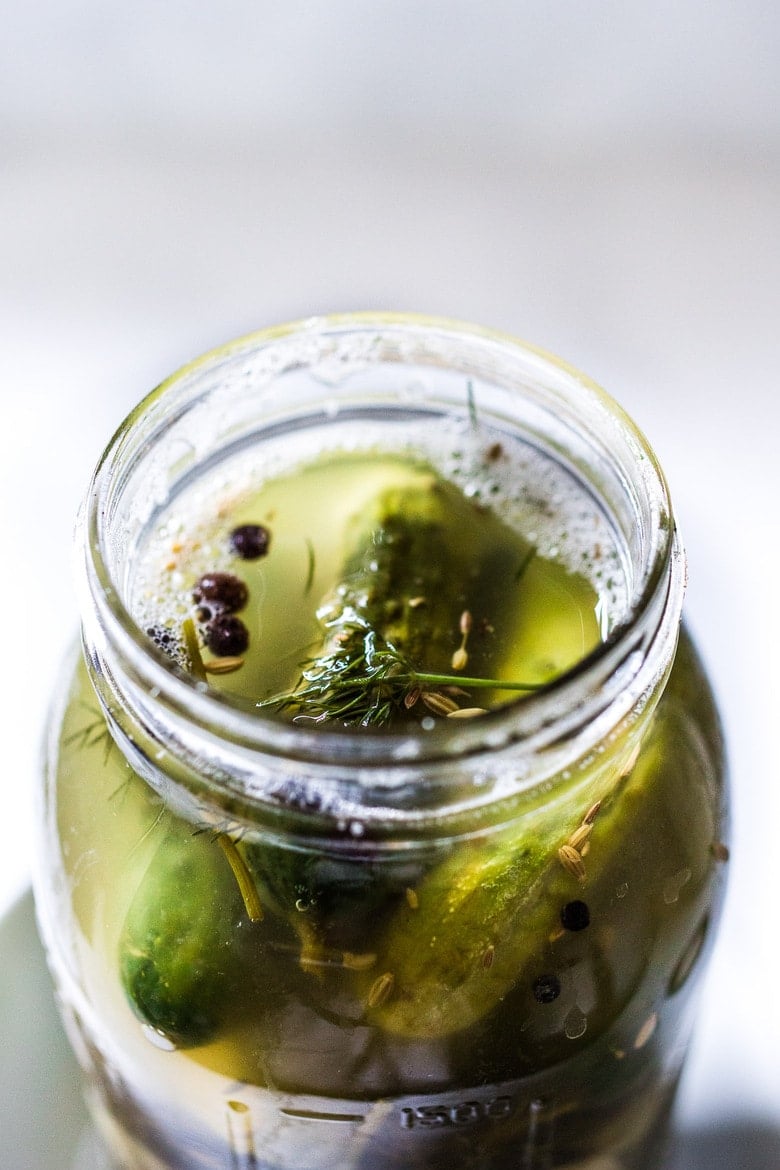
Once they are cold, give them a taste. They should be crunchy and flavorful! The brine is deliciously tangy, salty, and effervescent -so tasty and full of gut-supporting probiotics. The garlic is tasty too! Eat it!
I find myself often drinking shots of the brine! I also make this Gin & Brine Martini!
Let me know how you like this one in the comments below!
xoxoxo
More Favorite Ferments!
- Curtido & Cultured Salvadoran Slaw
- How to make Sauerkraut (Simple Cultured Cabbage)
- Beet and Cabbage Sauerkraut
- Cucumber Kimchi Pickles
- Turmeric Sauerkraut
More from Feasting at Home
How to make Fermented Pickles| 45-sec video
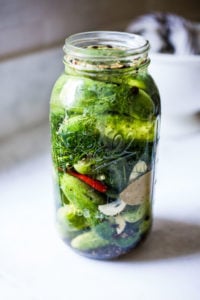
Homemade Pickles with Garlic and Dill
- Prep Time: 4 days
- Total Time: 4 days
- Yield: ½ gallon
- Category: fermented, preserved
- Method: fermented
- Cuisine: American
- Diet: Vegan
Description
How to make Manhattan-style, fermented Dill Pickles! A simple recipe for making the most flavorful, crunchy, tangy, garlic dill pickles with only 15 minutes of hands-on time. Full of healthy, gut-healing probiotics these little guys are perfect as a low-calorie snack, or sliced and added to sandwiches.
Ingredients
- 2– 2 1/2 lbs pickling cucumbers– all similar size ( 5 inches)
- 5 cups filtered water or tap water (that is not overly chlorinated)
- 2 tablespoons fine sea salt or Himalayan salt — or basically one heaping teaspoon fine sea salt (7 grams) per one cup of water, for a 3% brine (see notes)
- 1/4 teaspoon turmeric (optional, adds a “fresh” flavor)
- 1 teaspoon each: fennel seeds, coriander seeds, allspice, peppercorns, dill seeds, mustard seeds, celery seeds- and feel free to add more peppercorns!
- 10–20 garlic cloves, sliced (or double for extra garlicky)
- 1/2 onion, thinly sliced (optional)
- big handful of fresh dill
- 1–3 fresh red chilies – or dried arbol chilies, or add chili flakes (all optional)
- 3–4 bay leaves (or a grape leaf or oakleaf) – these are sources of tannic acid to help them stay crisp.
You’ll need a 1/2 gallon mason jar, crock, or 2 quart-sized jars- clean and sterile.
Instructions
- Prep Cucumbers: Rinse the cucumbers, remove 1/16-inch of the flower end of each cucumber (keeps them from getting soft) and place them in an ice-water bath, to crisp them up (15-30 minutes). Leave them whole.
- Make the brine: Mix salt (2 tablespoons) and 5 cups cold water until dissolved.
- Wash your hands, jar and any utensils. No need to sterilize, just clean!
- Assemble: In a large, clean two-quart mason jar, place all the whole spices into the bottom. Add the dill, garlic and onions or turmeric if using. With clean hands, pack one layer of cucumbers tightly, standing on end, then add the bay leaves, then add the second layer of cucumbers standing on end.
- Press everything down, leaving 1 ½ inches of headroom. Pour the salt water brine over the top and weigh down the cucumbers with fermentation weights so they are submerged under the brine. Remove any spices that may have floated to the surface (which can mold).
- Cover the jar loosely with a lid or with a cloth- basically, the pickles will bubble and you want air to be able to escape.
- Place the jar in a pan or bowl to collect any overflow and leave it in a cool dark place (60-70F) for 2 -3 days (a basement, or lower kitchen cupboard) and check for bubbles or overflow, indicating fermentation. Half sour pickles will take 3-5 days with crisp, white interiors. If is colder than 65F, it may take longer, if hotter, they will ferment faster. Full sour pickles will take 14-21 days (see notes for a stronger saltwater ratio).
- After 2 days, check for signs of life: bubbles, overflow, or clouding. Tap the jar, and see if tiny bubbles rise to the top. I usually ferment for 3-5 days. Longer ferments will yield tangier pickles but will get softer as they ferment, and lose their vibrant color. Up to you. You can taste them at any point after you see bubbles, and ferment longer if you like. The brine will get cloudy as it ferments- this is a good sign! Once you see active bubbles, you can at this point place the jar in the fridge, where it will continue to ferment, but much more slowly. Keep the pickles submerged.
- Once chilled, give them taste. They should be crispy and flavorful with a little tang. (At this point, if you want a tangier or softer pickle, you can absolutely pull them back out again and ferment for a few more days longer if you want.)
- If you like fizzy brine, tighten the lid, burping every week or so or try using an airlock. If you don’t want to think about it, give the lid one loose twist, so it’s on there, but gases can escape.
Notes
If you need more brine, make sure you use the same ratio- 1 heaping teaspoon sea salt per one cup of water.
If using a grape leaf, place it on the side of the jar, then layer the remaining ingredients.
If pickles turn out too soft- it may be due to too warm of temperature during fermentation, or the flower end wasn’t removed (the flower end of the cucumber has enzymes that can soften pickles).
Feel free to use 2, quart-size jars, dividing cucumbers, spices and brine between the jars.
BRINE: This recipe is a 3% salt water brine, which is considered “safe”. It equals 7 grams of salt per one cup of water. I’ve had really good luck with this ratio – and this ratio allows me to drink the brine (like a shot) this is really healthy – full of good gut-supporting bacteria!
If you want a stronger, saltier brine, feel free to go up to 4.5%. For a full sour pickle (14-21 days) use a 4.5% brine.
- 3% ratio = 7 grams salt per 1 cup of water. (1 1/4 teaspoon fine sea salt, per 1 cup water)
- 3.5% Ratio= 9 grams of salt per 1 cup of water. (1 1/2 teaspoon fine sea salt, per 1 cup water)
- 4.5% ratio 10.8 grams of salt per 1 cup of water. (2 teaspoons per cup of water)
Cutting the Cucumbers: I recommend leaving them whole. The texture is much better. After your first successful batch, feel free to experiment.
Nutrition
- Serving Size:
- Calories: 16
- Sugar: 1.3 g
- Sodium: 297.4 mg
- Fat: 0.2 g
- Saturated Fat: 0 g
- Carbohydrates: 3.7 g
- Fiber: 0.5 g
- Protein: 0.7 g
- Cholesterol: 0 mg
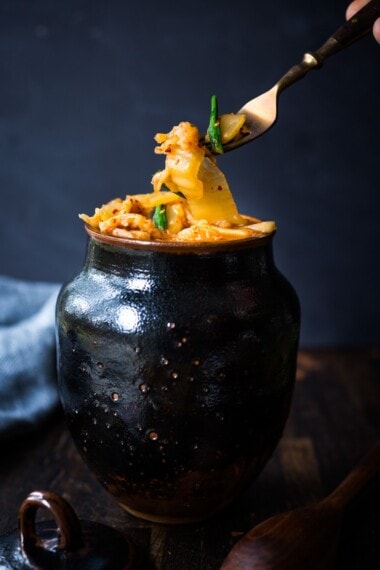
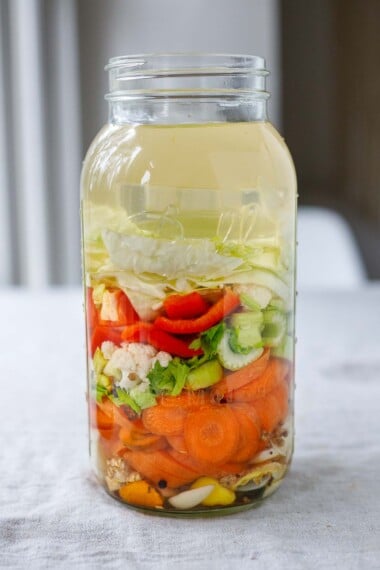
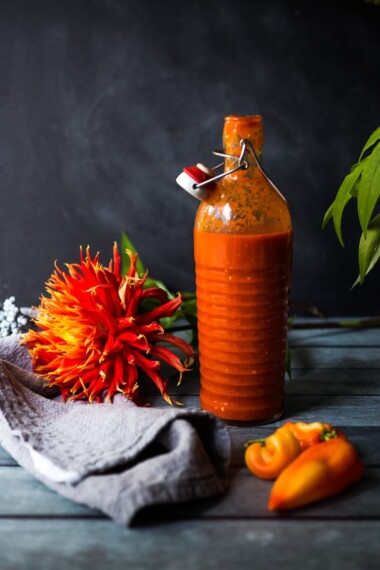

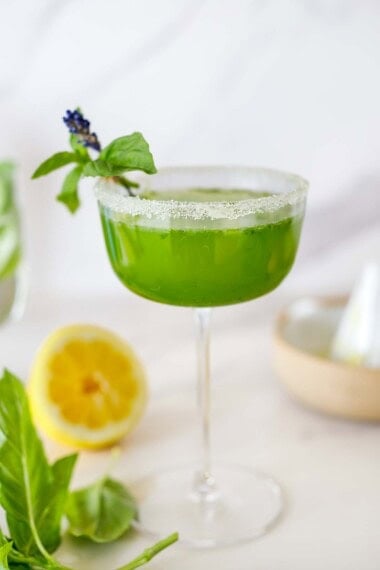
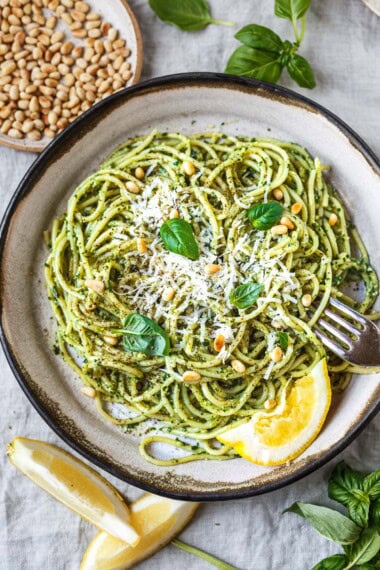

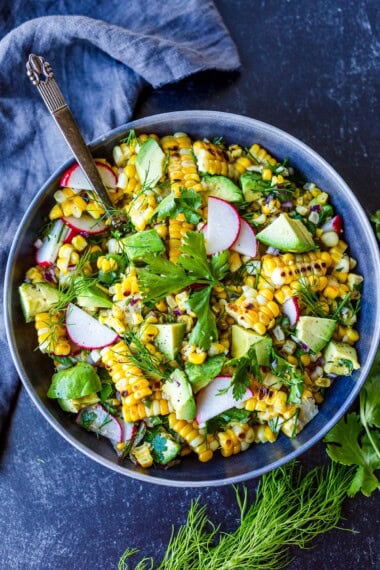
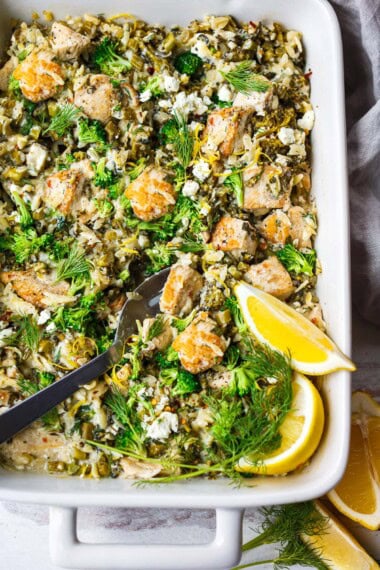
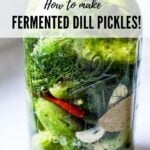
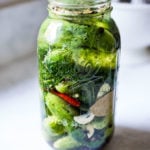
Hi just made these pickles. They are super easy. I have one question….. how do you burp these pickles and how often??
I honestly would just leave the lid on loose in the fridge ( turn a couple times). But if you must tighten it, burp every week or so?
Hello, just wanted to make sure I followed the recipe correctly. Should it be 2 tbsp of salt per 6 cups of water. I noticed in earlier comments that it was 3.5 tbsp per cup of water. Thanks
Hi you can use either!
Tanya, it would be 2 Tablespoons of salt per 6 cups of water. Add 1 teaspoon of salt per cup of water… so for 6 cups of water, you add 6 teaspoons of salt, which is the equivalent of 2 Tablespoons.
What you are doing is creating a brine with 2.5% salinity.
It is much more accurate to use a scale when you are measuring salt, and a general rule of thumb is 1 teaspoon of salt weighs about 6 grams.
Now think metric (I know, I know)… and use a little math and you can figure out any amount of salt for any amount of water. Here’s how:
Take the amount of water in milliliters (236 milliliters per cup) and multiply it by the percentage of salt you seek. Remember to always use metric!
So for a 2.5% brine with 1 cup (236 milliliters) of water:
236 milliliters (1 cup) water * 0.025 = 5.9 (you can round up to 6)
So use 6 grams of salt in 236 milliliters of water for a 2.5% brine.
Percentage must be in decimal form so 2% would be 0.02, 2.5% would be 0.025. If you’re not a math person, you can get the decimal form by simply dividing the percent form by 100. So 2.5 divided by 100 is 0.025.
Thanks for the clarification, helpful!
I love the taste . The water is a little cloudy, should I worry? I let the fermentation go on for 10 days. Many thanks for sharing this easy and tasty recipe.
Cloudy is a sign that lactofermentation is happening. Not a bad thing at all. Safe and fine to consume!
I’m so excited to try fermenting instead of pickling this year! Is it safe to use frozen dill? Thanks 🙂
That should be fine!
Hi Sylvia! Followed instructions. I live in a warm climate but ac is at 76-78 degrees. I put a few garlic cloves and used peppercorns, dried dill, 3 bay leaves,and mustard powder. I had no other spices on hand. Used cabbage leaves to push into brine. Covered with glass lid and a baggie and rubber band. Towel over all. In 5 days looked almost sour. Let it go to 6 days. No mold. Cloudy, a few bubbles, not a lot. I did use Himalayan salt which did turn garlic blue.
Put in fridge. Went full sour, but a bit mushy and some hollow.
Taste was ok, like a barrel pickle.
I put 2 spears in With whole cures, and they were good.
I have a couple of questions.. should I have put them in frig earlier, and why did they get hollow?
Have you ever used a touch of sugar?
Thanks!!!!
Hi Peggy! I haven’t tried, but think sugar would be good here. Great idea with the cabbage leaves. 🙂 What kind of cucumbers did you use? Perhaps the warmer temp caused these to ferment faster. Technically as soon as you see bubbles, you could refrigerate- especially if you like that crunchy texture like I do. 🙂
Hi Sylvia I used Kirby clues. My salt was strong at 3T for a quest of water.
That is quite a strong brine. I wonder if too salty?
Can I use dried dill (heads? Seeds? Stems?) instead of fresh? My dill came & went before the cukes produced. Also, do I use dried BAU leaves or fresh?
Yes feel free to use dried dill and seeds. What are BAU leaves? Sorry, my brain is tired right now!
How long do they last in the fridge? Love this recipe!
I’ve had mine for 6 months- should last as long as they are covered with the brine!
Great tutorial! I also cool ferment, not in fridge but a cooler place in the house. I have found from doing this for years that they will usually be a little crisper. Thanks for sharing!!
Perfect, thanks!
I made half the recipe because when I’ve used store bought dill pickles it takes me ages to finish the jar. I did them yesterday and already there’s action! Lots of bubbles.:) I like the idea of using Himalayan salt. And using all those pickling spices is going to produce amazing pickles. I don’t come from a family that ever did lacto-ferments. I’m on a quest to heal my digestive system. I find lacto-fermentation to be so creative and satisfying, not to mention yummy. These pickles will be devoured really quickly!
Great to hear! Hope you like them!
Love love love this recipe! My cucumber plants PRODUCED soo many this year and this has been the quickest, easiest to follow and tweak the seasoning. I’m sad to be making my last garden fresh batch but I now have a whole shelf in the fridge filled to last the next few months. Thank you!!!
I used green tomatoes – not cut it’s 9 days needs more flavor added more brine garlic, garlic, spices & dill @ bay leaves. Hope to try in a couple more days – hope this is nit too long.??
This recipe looks good! I tend to not use “sweet” mulling spices (like allspice) in my pickling spice, but the spices are purely personal preference. (The brine is the unalterable science while the spice is the art). I got my recipe from a Rabbi, who in turn got his from a congregant, a former 90 year old lower east side pickle vendor named Moe. Here’s the thread I started about it- there’s a ton of info here if you really want to dive in. https://www.chowhound.com/post/finally-real-honest-hashem-method-making-real-east-side-salt-805067
Thanks for the info.
One other question. I measured out 6 cups water,as I”m using 2 one quart mason jars, did the salt ratio but when I packed the cukes in the jars and poured the brine over Im left with approximately 2 cups of salt water. So my question is can I save that to use another day, with more salt water added, for another batch of something I might ferment. I just dont want to waste it and if its reuable shoul I refrig it till use?
Feel free to save and use, no refrigeration needed!
Slyvia, how did you sterilize your stone as that is what I”m going to use. I”m boiling it right now.
I did exactly that. Boiled it for like a half hour!
Straight forward, easy and very delicious. This is my ‘go to’ recipe for half shot and even full fermented cukes.
I have a question about using calcium chloride (pickle crisp). For vinegar pickles, I use 1/4tsp per qt of pickles tossed in the bottom of the jar prior to packing cucumbers I intend to water process. What about for these? Any ideas whether it’s possible, appropriate or even recommended?
Hi- I’m so sorry, I am not familiar with calcium chloride and don’t know how it affects the fermentation. Maybe someone else out there knows and can answer this?
I followed the recipe but used a 1 gal glass jar. After 5 days, last day in the fridge, pickles were not crisp or very flavorful. I added 1tsp calcium chloride and took them out and up in the basement. Hope that helps. Any suggestions?
Hi Bob, did you see signs of fermenting? Bubbles? Cloudiness? I’m not sure with calcium chloride will do to the fermentaion process.
Yes there were. Some bubbles. I added more bay leaves and garlic. My cellar is 62 degrees F.
I am seeing more bubbles.
A great sign, give them a few more days and see if they get any tangier.
Hi, this is my first time fermenting pickles. For years, I’ve picked in vinegar brine and canned them with the hot brine hot glass method for storage all year. So what I’m wondering is, I’ve just taken them out of the large crock barrel and placed into glass jars and lidded them. I’ve put them in the fridge, for now, but I made a huge batch and that’s a lot if space. Can I, without canning and getting a seal, place them in the basement for the year just as they are?
Second, one and a half pickles at the bottom of the crock barrel were moldy, will this effect the whole batch? (Two vertical layers.) I tossed the moldy ones. The brine is very murky white. I let the whole ceramic crock ferment for 11 days. (1/4 bushel of cucs). A very sour pickle, surprisingly so but pleasantly sour. The rest have soft tops but firm bodies.
The murky white is most likely a harmless yeast from the fermentation. Mold is usually at the top of the jar where the pickles touch air. Here is link that might be useful with troubleshooting- copy and paste into your browser. Hopefully this helps! https://extension.umn.edu/preserving-and-preparing/pickle-problems
Hi, this is my first time fermenting pickles. For years, I’ve picked in vinegar brine and canned them with the hot brine hot glass method for storage all year. So what I’m wondering is, I’ve just taken them out of the large crock barrel and placed into glass jars and lidded them. I’ve put them in the fridge, for now, but I made a huge batch and that’s a lot if space. Can I, without canning and getting a seal, place them in the basement for the year just as they are?
Hey Erika, that is a great question. Because they will continue to ferment, I believe they will get softer and tangier with time. I honestly don’t know what they would be like in a year!? I’ve only fermented these for a week max. maybe someone out there can answer this?
Okay thank you. I think I posted again but I added a second question.
Hi Sylvia,
I made these last Friday, and everything was going great until last night (day 3)…the jars were cloudy and producing bubbles. I put one jar in the refrigerator, then opened it to try a pickle and decided I wanted to ferment longer. I put the jar back in the cupboard, but today, that jar is quite cloudy and not producing bubbles. The other jar has mold growing on the top. 🙁 My question, besides what went wrong, is whether the second jar (without visible mold) might still be good. Any help is appreciated!
One other thing…can you open the jar before day 3, just to look, or is that a no-no?
Thank you!
Hi Stephanie, yes you can open the jar at any point, no problem. You can also scoop off the mold and save the pickles.:) The cloudy water is normal- a sign of lacto-fermentation. I think both the jars are probably ok, but if the mold scares you I understand. If it were me, I would remove mold, put it all in a clean jar-and refrigerate. Is it very warm there? If so, I’d just put both in the fridge and let them ferment more slowly, like for a week or so. Then try!
Thank you for your reply!!
Hi,
After the fermentation process when the pickles can go in the fridge should they be fully covered by the brine ? Or is it ok if they poke out a little ?
I like to keep them fully covered.
Hi! Thanks for the recipe! I just made this evening 4 jars of 1 liter each using white skin cucumbers, which being fat and long I first cut in half crosswise and then in spears. I decided to go for stronger brine adding 11/2 teaspoon salt per cup. Of spices I used what I had here: fresh dill, bay leaves, garlic, powder cumin, powder corriander, black pepper, and chili pepper flakes. Plan to keep lids tight and burp jars daily, keep them out in the cellar for 4 days and try them before going to the fridge. How does this sound to you? Much love from Lili
This sounds perfect Lili!
Many thanks! I am so glad I found your site, and will be following your recipes!!
Just a quick report, my white skin pickles cut in spears came out fantastic.
I kept them out in the cellar only 48 hours!! because of warm night temperatures where I am. I burped them during that time. After 48 hours I moved them to the fridge, on the 19th. Today, on the 21st, I checked all 4 jars, look already fermented, and tried a pickle. Just the right flavor! You would like the brine, not too salty, lovely to drink, I guess every country has salts of different salteness.
Thanks again for your great recipe, much love from Lili
Thanks Lili Great to hear and appreciate you sharing. Helpful!!!
So, I made these last week without any dill, because I didn’t have any, and they turned out great. Like, I want to eat another one right now great. This morning I picked up some more cukes from the farmers’ market and wanted to get a head of dill, but the guy who had them last week hadn’t brought any this week, so I bought a bunch of dill leaves instead. Yours is one of the few recipes online that uses the leaves–most people go for the flower heads gone to seed–so fingers crossed that they turn out just as good. For some reason, I’m afraid the dill leaves are going to turn to mush and disintegrate.
I’m glad I’ve finally tried lacto-fermented cucumbers, which I was kind of avoiding due to a memory of my dad making a wildly disastrous batch when I was a kid. I’ve spent the last few years enjoying really delicious homemade micro-batch sauerkraut all winter, and I missed having something sour and crunchy and probiotic to eat in the summer. I used 1 tablespoon of coarse pickling salt per pint of water (a formula I’d used before with fermented kohlrabi slices) because I didn’t have any suitable fine salt and wasn’t sure how to adjust your proportions for coarse: weight would be the same, obviously, but I don’t have a scale that measures weights that small, and if you measure by volume there’s a big difference between coarse and fine. Anyway, for anyone wondering about coarse salt by volume, the tablespoon to a pint formula works nicely. And these pickles are way better than fermented kohlrabi 🙂
Thanks for sharing Jennifer!
Hi Sylvia, thanks fro the great recipe. Never tried making fermented pickles before. Can I use regular screw lid jars rather than Mason jars? I have a few jam jars that I can use.
Thanks!
Yes, that should be fine! Be sure to burp them!
Your notes section is inaccurate and could cause harm.. “If you need more brine, make sure you use the same ratio- 1 teaspoon sea salt per one cup of water.”
Which should be 1 tablespoon.
Hopefully no one made this mistake, and read your instructions carefully.
Actually, it is 1 teaspoon per cup of water. NOT 1 tablespoon.
Just made a massive batch of these! Have made other ferments before but never pickles! Should I be worried about floating spices causing mold? Or will spices on the surface not cause mold? I know that’s a big cause of mold if it’s the vegetable itself so I just want to make sure seems how I made 10lbs of them!
Just make sure the veggies are submerged- the spices shouldn’t mold.
Love this recipe, but did I ruin my pickles?? I followed the recipe exactly but cut everything in half because I didn’t have enough cucumbers. Then I thought I’d like a little vinegar taste and added 1/4 cup. Does vinegar kill the fermentation process? Are they unsafe? Is there a fix? It’s been four days and I don’t see bubbles. Thanks.
Hi, what kind of vinegar did you use? The thing is when you ferment, they actually do get tangy naturally without the vinegar. Maybe if you use AC vinegar “with the mother in it”, this could work in very small doses, but my guess is if you don’t see bubbles, yes it may have inhibited the fermentation.
I added 1/4 cup of 5% distilled white vinegar. I saw 2 bubbles today, after 5 days, but I suspect that’s not enough. Can these pickles be saved? Thanks for your advice.
I guess you could refrigerate and try a piece of one if it smells ok? Well that is what I would do.:) At this point without knowing if they fermented- I might just pickle them, add more vinegar to the brine and keep them in the fridge. My guess is they are probably ok, but I only guessing here, I can’t see them, so use your best judgment.
After 7 days, the pickle on top has a couple of soft spots on it and I tossed it. Perhaps it was not fully submerged — should I be concerned about the other pickles? The taste is exactly as I expected and the brine is delicious!
How did they look before you fermented? I think as long as they are submerged, they should be ok?